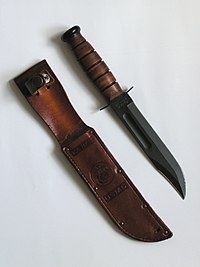

Bayonet for the Lee-Enfield Rifle No. 5 Mk I "Jungle Carbine"
A fuller is a tool used in the trade of black smithing to produce rounded or beveled groove or slot in the flat side of a blade (e.g. a sword, knife, or bayonet). A fuller is often used to lighten the blade, much the way that the shape of an I-beam allows a given amount of strength to be achieved with less material. When combined with proper distal tapers, heat treatment and blade tempering, a fullered blade can be 20% to 35% lighter than a non-fullered blade without any sacrifice of strength or blade integrity. This effect lessens as the blade is reduced in length. While this groove is often called a "fuller" by sword enthusiasts, it is the tool used to make the groove which is actually a fuller and the blade is said to be "fullered" after introduction of the groove.
Physics[]

Figure 2. Internal forces and the cross-sectional stress distribution due to bending.
The basic design principle is that bending causes more stress in material near the edge or back of the blade than material in the middle, due to leverage. The diagram at right shows stress distribution in an ideal blade with a rectangular section, with only a small amount of normal stress present at the neutral axis. Fullers remove material from near this neutral axis, which is closer to the blade's spine if only one edge is sharpened (see photo above). This yields stiffer blades of a given weight, or lighter blades of a given stiffness. The same principle is taken to an extreme in I-beams.
Japanese blades[]
In Japanese bladesmithing, fullers have a rich tradition and terminology, enough that there are separate terminologies for the top (hi, usually pronounced as bi when used as a successive word) and bottom (tome) ends of the feature. A listing follows:

USMC-issue Ka-Bar knife with fuller
- Hi
- Bo-bi: A continuous straight groove of notable width, known as katana-bi on tantō. With soe-bi, a secondary narrow groove follows the inner straight length of the main one. With tsure-bi, the secondary is similar but continues beyond the straight length.
- Futasuji-bi: Two parallel grooves.
- Shobu-bi: A groove shaped like the leaf of an iris plant.
- Naginata-bi: A miniature bo-bi whose top is oriented opposite from the blade's, and usually accompanied by a soe-bi. Seen primarily on naginatas.
- Kuichigai-bi: Two thin grooves that run the top half of the blade; the bottom half is denoted by the outer groove stopping halfway while the inner one expands to fill the width.
- Koshi-bi: A short rounded-top groove found near the bottom of a blade, near to the tang.
- Tome
- Kaki-toshi: The groove runs all the way down to the end of the tang.
- Kaki-nagashi: The groove tapers to a pointed end halfway down the tang.
- Kaku-dome: The groove stops as a square end within 3 cm of the tang's upper end.
- Maru-dome: Similar to the kaku, except with a rounded-end.
The kukri[]
The Nepali kukri has a terminology of its own, including the "aunlo bal" (finger of strength/force/energy), a relatively deep and narrow fuller near the spine of the blade, which runs (at most) between the handle and the corner of the blade, and the "chirra", which may refer either to shallow fullers in the belly of the blade or a hollow grind of the edge, and of which two or three may be used on each side of the blade.[1]
References[]
- "Blood groove", from the A. G. Russell knife encyclopedia
- Terminology of the Kukri
- [American blacksmithing by J Holmstrom]
- [The art of blacksmithing by Alex Bealer]
The original article can be found at Fuller (weapon) and the edit history here.